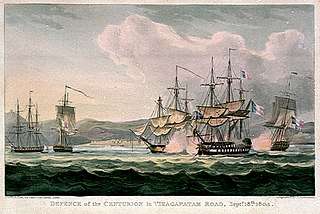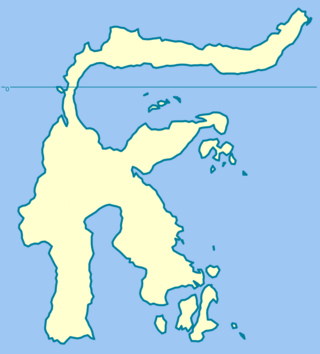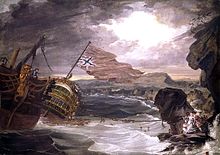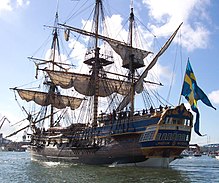
The Battle of Pulo Aura was a minor naval engagement of the Napoleonic Wars, fought on 14 February 1804, in which a large convoy of Honourable East India Company (HEIC) East Indiamen, well-armed merchant ships, intimidated, drove off and chased away a powerful French naval squadron. Although the French force was much stronger than the British convoy, Commodore Nathaniel Dance's aggressive tactics persuaded Contre-Admiral Charles-Alexandre Durand Linois to retire after only a brief exchange of shot. Dance then chased the French warships until his convoy was out of danger, whereupon he resumed his passage toward British India. Linois later claimed that the unescorted British merchant fleet was defended by eight ships of the line, a claim criticised by contemporary officers and later historians.

Charles-Alexandre Léon Durand, Comte de Linois was a French admiral who served in the French Navy during the reign of Napoleon Bonaparte. He commanded the combined Franco-Spanish fleet during the Algeciras Campaign in 1801, winning the First Battle of Algeciras before losing the Second Battle of Algeciras. He then led an unsuccessful campaign against British trade in the Indian Ocean and South China Sea in 1803, being defeated by a harmless fleet of the East India Company during the Battle of Pulo Aura and ending his cruise and sea-going career being bested in battle by John Warren in the action of 13 March 1806. Following the Bourbon restoration, Linois was appointed Governor of Guadeloupe. He supported Napoleon during the Hundred Days and so, on his return to France, he was forced to resign and was court martialled. Although acquitted, he was placed in retirement and never served again.

Blackwall frigate was the colloquial name for a type of three-masted full-rigged ship built between the late 1830s and the mid-1870s.

The Sémillante was a 32-gun frigate of the French Navy and the lead ship of her class. She was involved in a number of multi-vessel actions against the Royal Navy, particularly in the Indian Ocean. She captured a number of East Indiamen before she became so damaged that the French disarmed her and turned her into a merchant vessel. The British captured her and broke her up in 1809.

The action of 31 May 1809 was a naval skirmish in the Bay of Bengal during the Napoleonic Wars. During the action, an Honourable East India Company convoy carrying goods worth over £500,000 was attacked and partially captured by the French frigate Caroline. The three East Indiamen that made up the convoy fought against their opponent with their own batteries of cannon but ultimately were less powerful, less manoeuvrable and less trained than their opponent and were defeated one by one; only the smallest of the three escaped. The action was the first in a string of attacks on important convoys in the Indian Ocean by French cruisers operating from Île de France and Île Bonaparte during a concerted campaign against British shipping in the region.

Jean-Jacques Rousseau was a Téméraire class 74-gun ship of the line of the French Navy, active during the French Directory, French Consulate and First French Empire. Renamed Marengo in 1802, she took part in Linois' operations in the Indian Ocean before her capture by the Royal Navy.
Britannia may refer to any one of a large number of ships:

Linois's expedition to the Indian Ocean was a commerce raiding operation launched by the French Navy during the Napoleonic Wars. Contre-Admiral Charles-Alexandre Durand Linois was ordered to the Indian Ocean in his flagship Marengo in March 1803 accompanied by a squadron of three frigates, shortly before the end of the Peace of Amiens. When war between Britain and France broke out in September 1803, Marengo was at Pondicherry with the frigates, but escaped a British squadron sent to intercept it and reached Isle de France. The large distances between naval bases in the Indian Ocean and the limited resources available to the British commanders in the region made it difficult to concentrate sufficient forces to combat a squadron of this size, and Linois was subsequently able to sustain his campaign for three years. From Isle de France, Linois and his frigates began a series of attacks on British commerce across the Eastern Indian Ocean, specifically targeting the large convoys of East Indiamen that were vital to the maintenance of trade within the British Empire and to the British economy. Although he had a number of successes against individual merchant ships and the small British trading post of Bencoolen, the first military test of Linois squadron came at the Battle of Pulo Aura on 15 February 1804. Linois attacked the undefended British China Fleet, consisting of 16 valuable East Indiamen and 14 other vessels, but failed to press his military superiority and withdrew without capturing a single ship.

The Battle of Vizagapatam was a minor naval engagement fought in the approaches to Vizagapatam harbour in the Coastal Andhra region of British India on the Bay of Bengal on 15 September 1804 during the Napoleonic Wars. A French squadron under Contre-Admiral Charles-Alexandre Léon Durand Linois in the ship of the line Marengo attacked the British Royal Navy fourth rate ship HMS Centurion and two East Indiaman merchant ships anchored in the harbour roads. Linois was engaged in an extended raiding campaign, which had already involved operations in the South China Sea, in the Mozambique Channel, off Ceylon and along the Indian coast of the Bay of Bengal. The French squadron had fought one notable engagement, at the Battle of Pulo Aura on 15 February 1804, in which Linois had attacked the Honourable East India Company's (HEIC) China Fleet, a large convoy of well-armed merchant ships carrying cargo worth £8 million. Linois failed to press the attack and withdrew with the convoy at his mercy, invoking the anger of Napoleon when the news reached France.

The action of 13 March 1806 was a naval engagement of the Napoleonic Wars, fought when a British and a French squadron met unexpectedly in the mid-Atlantic. Neither force was aware of the presence of the other prior to the encounter and were participating in separate campaigns. The British squadron consisted of seven ships of the line accompanied by associated frigates, led by Rear-Admiral Sir John Borlase Warren, were tasked with hunting down and destroying the French squadron of Contre-Admiral Jean-Baptiste Willaumez, which had departed Brest for raiding operations in the South Atlantic in December 1805, at the start of the Atlantic campaign of 1806. The French force consisted of one ship of the line and one frigate, all that remained of Contre-Admiral Charles-Alexandre Durand Linois' squadron that had sailed for the Indian Ocean in March 1803 during the Peace of Amiens. Linois raided British shipping lanes and harbours across the region, achieving limited success against undefended merchant ships but repeatedly withdrawing in the face of determined opposition, most notably at the Battle of Pulo Aura in February 1804. With his stores almost exhausted and the French ports east of the Cape of Good Hope that could have offered him replenishment eliminated, Linois decided to return to France in January 1806, and by March was inadvertently sailing across the cruising ground of Warren's squadron.
The action of 4 August 1800 was a highly unusual naval engagement that took place off the Brazilian coast during the French Revolutionary Wars. A French frigate force that had been raiding British commerce off West Africa approached and attempted to attack a convoy of valuable East Indiamen, two ships sailing for Botany Bay, and a whaler sailing for the South Seas' whale fishery. The small British ship of the line HMS Belliqueux escorted the convoy, which otherwise had to rely on the ships' individual armament to protect them from attack. Due to their large size, the East Indiamen could be mistaken for ships of the line at a distance, and the French commander Commodore Jean-François Landolphe was un-nerved when the convoy formed a line of battle. Supposing his target to be a fleet of powerful warships he turned to escape and the British commander, Captain Rowley Bulteel, immediately ordered a pursuit. To preserve the impression of warships he also ordered four of his most powerful East Indiamen to join the chase.

The action of 26 July 1806 was a minor naval engagement of the Napoleonic Wars fought off the southern coast of the island of Celebes in the Dutch East Indies. During the battle, a small British squadron attacked and defeated a Dutch force defending a valuable convoy, which was also captured. The British force—consisting of the frigate HMS Greyhound and brig-sloop HMS Harrier under the command of Captain Edward Elphinstone—was initially wary of the Dutch, mistaking the Dutch East Indiaman merchant ship Victoria for a ship of the line. Closer observation revealed the identity of the Dutch vessels the following day and Elphinstone led his frigate against the leading Dutch warship Pallas while Harrier engaged the merchant vessels and forced them to surrender. Only the corvette William escaped, taking no part in the engagement.

The Sunda Strait campaign of January 1794 was a series of manoeuvres and naval actions fought between warships and privateers of the French Republic and a squadron of vessels sent by the British East India Company to protect trade in the region, later augmented by Dutch warships. The campaign developed as French forces based on Île de France reacted more quickly than the British forces in the Indian Ocean to the expansion of the French Revolutionary Wars on 1 February 1793. French privateers rapidly spread along the British trade routes in the Far East, becoming concentrated around the narrow Sunda Strait between the islands of Java and Sumatra in the Dutch East Indies. These ships were soon joined by French Navy frigates and began to inflict losses on shipping in the region. The Royal Navy forces in the Indian Ocean were deployed elsewhere and so the East India Company, the private enterprise that ruled much of British India in the 1790s and maintained their own fleet and navy, raised a squadron of armed merchant ships to patrol the Strait and drive off the raiders.
Several ships have been named London for the city of London:
Indefatigable was a square-rigged, three-decked, three-masted merchant ship launched in 1799 at Whitby for James Atty & Co. for the West Indies trade. In 1804 she served as an armed defense ship and recaptured a merchantman that a privateer had captured. She was a transport in the 1805–1806 British invasion of the Dutch Cape colony. She twice transported convicts to Australia; on the first trip she was chartered to the British East India Company (EIC). She burned to the waterline in 1815.
A number of vessels have been named Alexander:
Numerous ships with the name Phoenix, for the constellation or the mythical bird, have sailed for the British East India Company (EIC) between 1680 and 1821:

West Indiaman was a general name for any merchantman sailing ship making runs from the Old World to the West Indies and the east coast of the Americas. These ships were generally strong ocean-going ships capable of handling storms in the Atlantic Ocean. The term was used to refer to vessels belonging to the Danish, Dutch, English, and French West India companies.
Brunswick was launched in 1792 as an East Indiaman for the British East India Company (EIC). She made five complete voyages for the EIC before the French captured her in 1805. Shortly thereafter she wrecked at the Cape of Good Hope.
Several ships have borne the name Caledonia for Caledonia:















